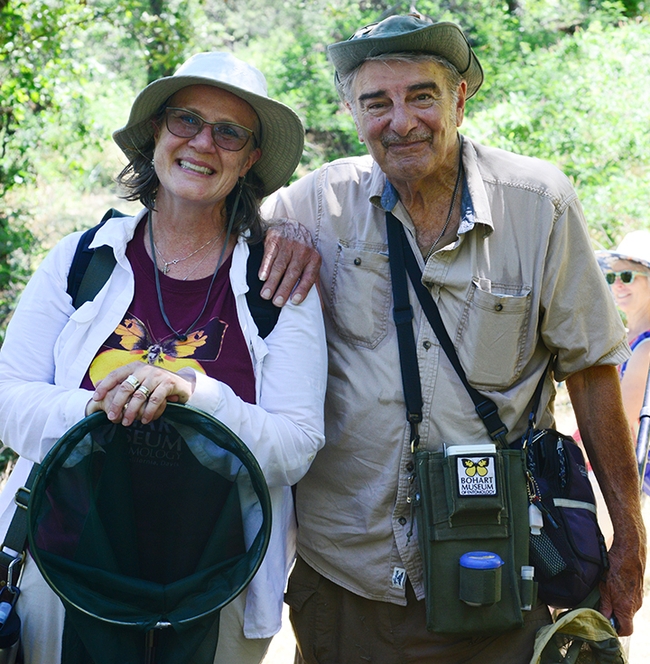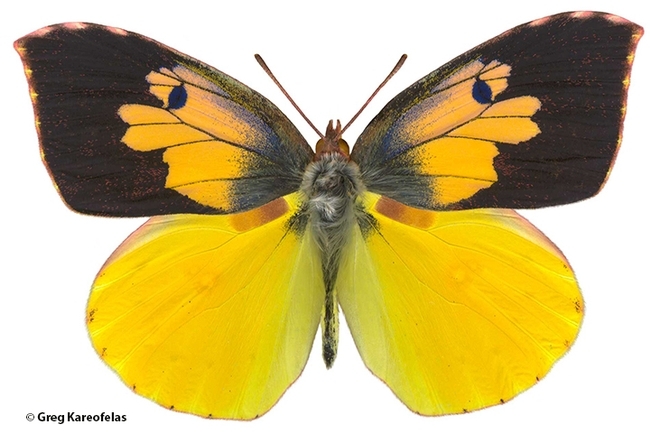
It's an opportunity to learn more about the biology and history of California's state insect, the California dogface butterfly.
The Bohart Museum of Entomology will showcase and celebrate the butterfly at its open house from 1 to 4 p.m., Saturday, July 16. The free, family friendly event takes place in Room 1124 of the Academic Surge Building, 455 Crocker Lane, UC Davis campus.
What's so special about this? First of all, it's our state insect. Second of all, you've probably never noticed it, especially in the wild. And perhaps more significantly, this is the 50th anniversary of the year that the state Legislature designated Zerene eurydice as the state insect. Gov. Ronald Reagan signed it into law on July 28, 1972.
Found only in California, the rarely seen butterfly is also known as (1) "the flying pansy," referring to the male's spectacular black and yellow coloring, and (2) as a "dog head" butterfly (the markings on the male resemble a silhouette of a dog's head). The female is mostly solid yellow.
The butterfly's major breeding ground is in Auburn at a preserve maintained by the Placer Land Trust (PLT). The butterfly is there because its larval host plant--false indigo (Amorpha californica)--grows well there. Its range includes San Diego to Sonoma counties and it'susually found in mountain and foothill locations," according to PLT. Butterfly guru Art Shapiro, UC Davis distinguished professor of evolution and ecology, has seen it multiple times in Gates Canyon, Vacaville.

However, no one has been able to reach any of the former students to invite them as special guests to the open house.
In 2013, Fran Keller, a UC Davis doctoral alumnus and now a professor at Folsom Lake College, published a 35-page children's book, The Story of the Dogface Butterfly that includes includes photos by Kareofelas and Keller and illustrations by then UC Davis student Laine Bauer. They earlier created a poster. Both the book and the poster are available for sale in the gift shop at the Bohart Museum.
The book tells the untold story of the California dogface butterfly, and how schoolchildren became involved in convincing the State Legislature to select the dogface butterfly as the state insect. As part of their research, Keller, Kareofelas and Bauer visited the Placer Land Trust habitat of the butterfly. Kareofelas reared the insect from egg to adult, photographing all stages.
The history of how the butterfly became the state insect actually begins in the 1920s with the Lorquin Entomological Society of Los Angeles. In an October 1929 article in The Pan-Pacific Entomologist, a publication of the Pacific Coast Entomological Society, J. D. Dunder of Pasadena credits the Lorquin Entomological Society with seeking "to establish a state insect for California." Out of three choices, the group voted on the California dogface butterfly.
Dunder wrote that the butterfly is "strictly a native California butterfly" and that "thousands of specimens are used each year in entomological art work for trays, bookends, plaques, etc., so the species is already fairly well known to the pubic."
Today its image graces a first-class U.S. stamp and our California driver licenses. It's also depicted on the California State Fair monorail. The Lone Buffalo Vineyards and Winery, Auburn, memorialized it on labels of specially bottled wine, with proceeds helping conservation efforts of the Placer Land Trust to protect the butterfly.
Officials at the Bohart Museum are, no doubt one, some of the butterfly's biggest fans and they'll share their scientific knowledge and enthusiasm for the state insect at their Saturday, July 16 open house. You'll see Kareofelas' amazing slide show of the butterfly's life cycle. A family arts-and-crafts activity is also planned.
The Bohart Museum, home of a worldwide collection of 8 million insects, is directed by UC Davis distinguished professor Lynn Kimsey. It also houses a live "petting zoo" (Madagascar hissing cockroaches, stick insects and tarantulas) and an insect-themed gift shop.
Attached Images:
